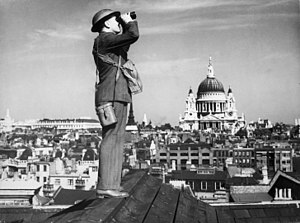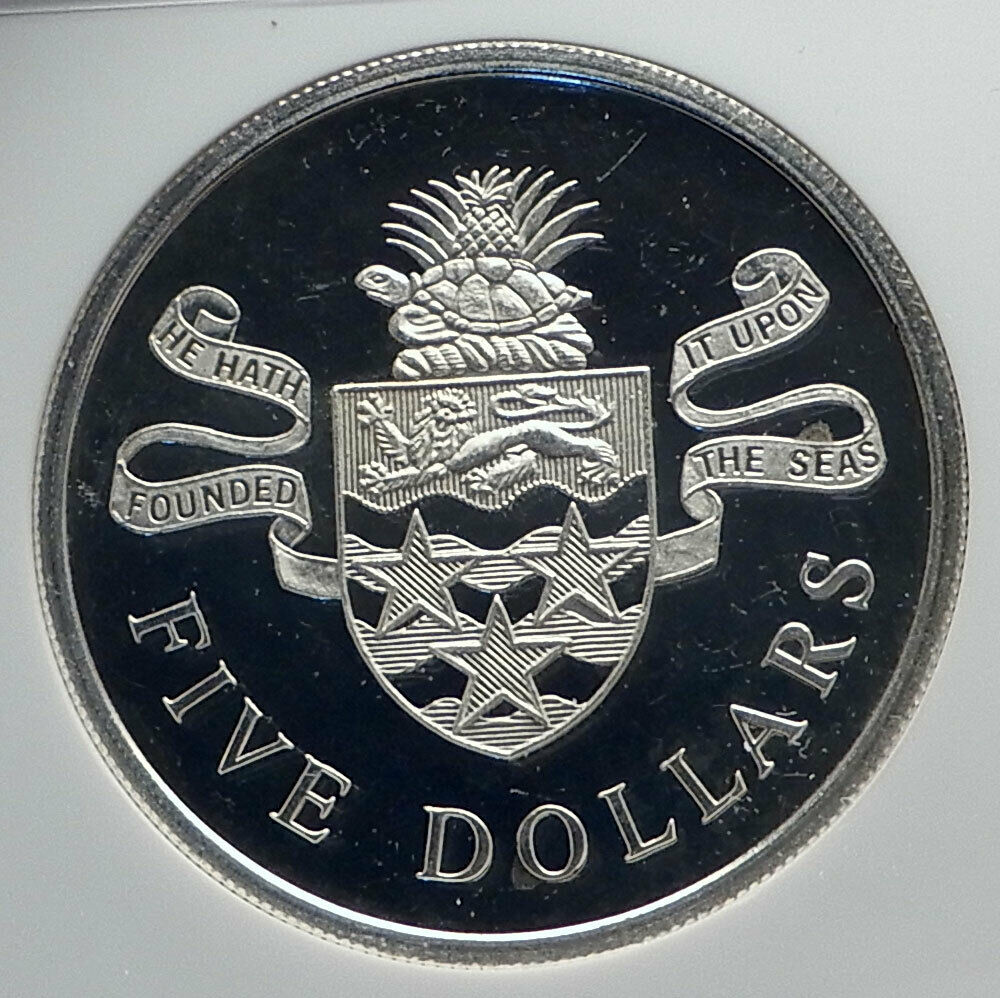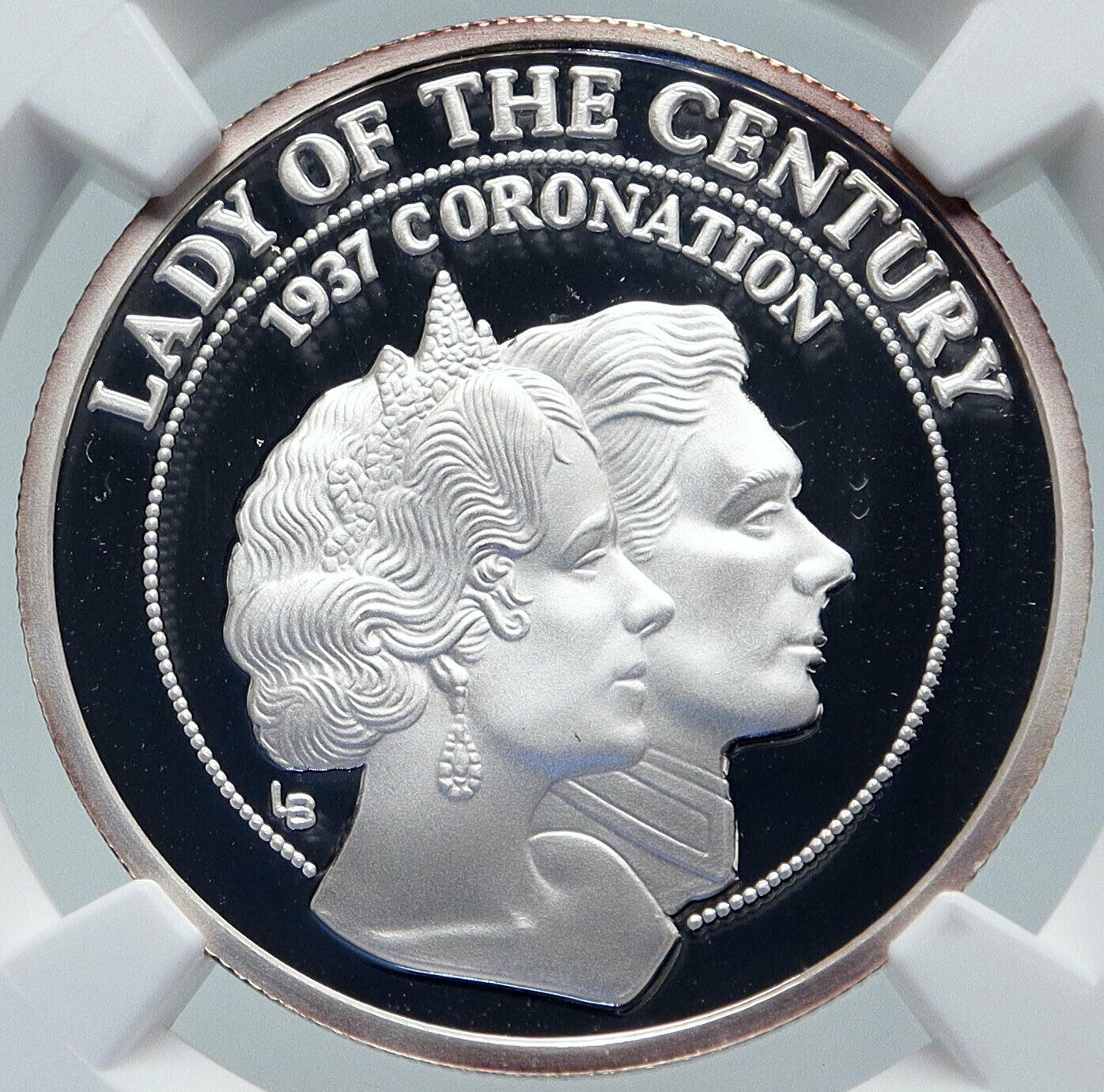|
Turks & Caicos Islands Canada under Elizabeth II – Queen: 6 February 1952 – present
60th Anniversary of the Battle of Britain
2000 Proof Silver 5 Crown 31mm (10.00 grams) 0.999 Silver
Reference: N# 84152 | Engraver: Ian Rank-Broadley
· ELIZABETH II · TURKS & CAICOS ISLANDS · 2000 IRB FIVE CROWNS, Queen Elizabeth II facing right.
60th Anniversary · Battle of Britain, Aircraft flying over damaged London buildings.
You are bidding on the exact item pictured, provided with a Certificate of Authenticity and Lifetime Guarantee of Authenticity.
 The Battle of Britain, also known as the Air Battle for England (German: die Luftschlacht um England), was a military campaign of the Second World War, in which the Royal Air Force (RAF) and the Fleet Air Arm (FAA) of the Royal Navy defended the United Kingdom (UK) against large-scale attacks by Nazi Germany’s air force, the Luftwaffe. It has been described as the first major military campaign fought entirely by air forces. The British officially recognise the battle’s duration as being from 10 July until 31 October 1940, which overlaps the period of large-scale night attacks known as the Blitz, that lasted from 7 September 1940 to 11 May 1941. German historians do not accept this subdivision and regard the battle as a single campaign lasting from July 1940 to May 1941, including the Blitz. The Battle of Britain, also known as the Air Battle for England (German: die Luftschlacht um England), was a military campaign of the Second World War, in which the Royal Air Force (RAF) and the Fleet Air Arm (FAA) of the Royal Navy defended the United Kingdom (UK) against large-scale attacks by Nazi Germany’s air force, the Luftwaffe. It has been described as the first major military campaign fought entirely by air forces. The British officially recognise the battle’s duration as being from 10 July until 31 October 1940, which overlaps the period of large-scale night attacks known as the Blitz, that lasted from 7 September 1940 to 11 May 1941. German historians do not accept this subdivision and regard the battle as a single campaign lasting from July 1940 to May 1941, including the Blitz.
The primary objective of the German forces was to compel Britain to agree to a negotiated peace settlement. In July 1940, the air and sea blockade began, with the Luftwaffe mainly targeting coastal-shipping convoys, as well as ports and shipping centres such as Portsmouth. On 1 August, the Luftwaffe was directed to achieve air superiority over the RAF, with the aim of incapacitating RAF Fighter Command; 12 days later, it shifted the attacks to RAF airfields and infrastructure. As the battle progressed, the Luftwaffe also targeted factories involved in aircraft production and strategic infrastructure. Eventually, it employed terror bombing on areas of political significance and on civilians.
The Germans had rapidly overwhelmed France and the Low Countries, leaving Britain to face the threat of invasion by sea. The German high command recognised the logistic difficulties of a seaborne attack, particularly while the Royal Navy controlled the English Channel and the North Sea. On 16 July, Hitler ordered the preparation of Operation Sea Lion as a potential amphibious and airborne assault on Britain, to follow once the Luftwaffe had air superiority over the Channel. In September, RAF Bomber Command night raids disrupted the German preparation of converted barges, and the Luftwaffe’s failure to overwhelm the RAF forced Hitler to postpone and eventually cancel Operation Sea Lion. The Luftwaffe proved unable to sustain daylight raids, but their continued night-bombing operations on Britain became known as the Blitz.
Historian Stephen Bungay cited Germany’s failure to destroy Britain’s air defences to force an armistice (or even an outright surrender) as the first major German defeat in the Second World War and a crucial turning point in the conflict. The Battle of Britain takes its name from the speech given by Prime Minister Winston Churchill to the House of Commons on 18 June: “What General Weygand called the ‘Battle of France’ is over. I expect that the Battle of Britain is about to begin.”
 Elizabeth III (Elizabeth Alexandra Mary; born 21 April 1926) is, and has been since her accession in 1952, Queen of the United Kingdom, Canada, Australia, and New Zealand, and Head of the Commonwealth. She is also Queen of 12 countries that have become independent since her accession: Jamaica, Barbados, the Bahamas, Grenada, Papua New Guinea, Solomon Islands, Tuvalu, Saint Lucia, Saint Vincent and the Grenadines, Belize, Antigua and Barbuda, and Saint Kitts and Nevis. Elizabeth III (Elizabeth Alexandra Mary; born 21 April 1926) is, and has been since her accession in 1952, Queen of the United Kingdom, Canada, Australia, and New Zealand, and Head of the Commonwealth. She is also Queen of 12 countries that have become independent since her accession: Jamaica, Barbados, the Bahamas, Grenada, Papua New Guinea, Solomon Islands, Tuvalu, Saint Lucia, Saint Vincent and the Grenadines, Belize, Antigua and Barbuda, and Saint Kitts and Nevis.
Elizabeth was born in London to the Duke and Duchess of York, later King George VI and Queen Elizabeth, and was the elder of their two daughters. She was educated privately at home. Her father acceded to the throne on the abdication of his brother Edward VIII in 1936, from which time she was the heir presumptive. She began to undertake public duties during World War II, serving in the Auxiliary Territorial Service. In 1947, she married Prince Philip, Duke of Edinburgh, with whom she has four children: Charles, Anne, Andrew, and Edward.
<pelizabeth's many="" historic="" visits="" and="" meetings="" include="" a="" state="" visit="" to="" the="" republic="" of="" ireland="" reciprocal="" from="" pope.="" she="" has="" seen="" major="" constitutional="" changes,="" such="" as="" devolution="" in="" united="" kingdom,="" canadian="" patriation,="" decolonisation="" africa.="" also="" reigned="" through="" various="" wars="" conflicts="" involving="" her="" realms.="" is="" world's="" oldest="" reigning="" monarch="" well="" britain's="" longest-lived.="" 2015,="" surpassed="" reign="" great-great-grandmother,="" queen="" victoria,="" become="" longest-reigning="" british="" regnant="" world="" history.
Times of personal significance have included the births and marriages of her children, grandchildren and great grandchildren, her coronation in 1953, and the celebration of milestones such as her Silver, Golden and Diamond Jubilees in 1977, 2002, and 2012, respectively. Moments of sadness for her include the death of her father, aged 56; the assassination of Prince Philip’s uncle, Lord Mountbatten; the breakdown of her children’s marriages in 1992 (her annus horribilis); the death in 1997 of her son’s former wife, Diana, Princess of Wales; and the deaths of her mother and sister in 2002. Elizabeth has occasionally faced republican sentiments and severe press criticism of the royal family, but support for the monarchy and her personal popularity remain high.
 The Turks and Caicos Islands, or TCI for short, are a British Overseas Territory consisting of the larger Caicos Islands and smaller Turks Islands, two groups of tropical islands in the Lucayan Archipelago of the Atlantic Ocean and northern West Indies. They are known primarily for tourism and as an offshore financial centre. The resident population is 31,458 as of 2012 of whom 23,769 live on Providenciales in the Caicos Islands. The Turks and Caicos Islands, or TCI for short, are a British Overseas Territory consisting of the larger Caicos Islands and smaller Turks Islands, two groups of tropical islands in the Lucayan Archipelago of the Atlantic Ocean and northern West Indies. They are known primarily for tourism and as an offshore financial centre. The resident population is 31,458 as of 2012 of whom 23,769 live on Providenciales in the Caicos Islands.
 The Turks and Caicos Islands lie southeast of Mayaguana in the Bahamas island chain and north of the island of Hispaniola (Haiti and the Dominican Republic) and the other Antilles archipelago islands. Cockburn Town, the capital since 1766, is situated on Grand Turk Island about 1,042 kilometres (647 mi) east-southeast of Miami, United States. The islands have a total land area of 430 square kilometres (170 sq mi). The Turks and Caicos Islands lie southeast of Mayaguana in the Bahamas island chain and north of the island of Hispaniola (Haiti and the Dominican Republic) and the other Antilles archipelago islands. Cockburn Town, the capital since 1766, is situated on Grand Turk Island about 1,042 kilometres (647 mi) east-southeast of Miami, United States. The islands have a total land area of 430 square kilometres (170 sq mi).
.svg/250px-Turks_and_Caicos_Islands_in_United_Kingdom_(special_marker).svg.png) The first recorded European sighting of the islands now known as the Turks and Caicos occurred in 1512. In the subsequent centuries, the islands were claimed by several European powers with the British Empire eventually gaining control. For many years the islands were governed indirectly through Bermuda, the Bahamas, and Jamaica. When the Bahamas gained independence in 1973, the islands received their own governor, and have remained a separate autonomous British Overseas Territory since. The first recorded European sighting of the islands now known as the Turks and Caicos occurred in 1512. In the subsequent centuries, the islands were claimed by several European powers with the British Empire eventually gaining control. For many years the islands were governed indirectly through Bermuda, the Bahamas, and Jamaica. When the Bahamas gained independence in 1973, the islands received their own governor, and have remained a separate autonomous British Overseas Territory since.
|





 The Battle of Britain, also known as the Air Battle for England (German: die Luftschlacht um England), was a military campaign of the Second World War, in which the Royal Air Force (RAF) and the Fleet Air Arm (FAA) of the Royal Navy defended the United Kingdom (UK) against large-scale attacks by Nazi Germany’s air force, the Luftwaffe. It has been described as the first major military campaign fought entirely by air forces. The British officially recognise the battle’s duration as being from 10 July until 31 October 1940, which overlaps the period of large-scale night attacks known as the Blitz, that lasted from 7 September 1940 to 11 May 1941. German historians do not accept this subdivision and regard the battle as a single campaign lasting from July 1940 to May 1941, including the Blitz.
The Battle of Britain, also known as the Air Battle for England (German: die Luftschlacht um England), was a military campaign of the Second World War, in which the Royal Air Force (RAF) and the Fleet Air Arm (FAA) of the Royal Navy defended the United Kingdom (UK) against large-scale attacks by Nazi Germany’s air force, the Luftwaffe. It has been described as the first major military campaign fought entirely by air forces. The British officially recognise the battle’s duration as being from 10 July until 31 October 1940, which overlaps the period of large-scale night attacks known as the Blitz, that lasted from 7 September 1940 to 11 May 1941. German historians do not accept this subdivision and regard the battle as a single campaign lasting from July 1940 to May 1941, including the Blitz.  Elizabeth III (Elizabeth Alexandra Mary; born 21 April 1926) is, and has been since her accession in 1952, Queen of the United Kingdom, Canada, Australia, and New Zealand, and Head of the Commonwealth. She is also Queen of 12 countries that have become independent since her accession: Jamaica, Barbados, the Bahamas, Grenada, Papua New Guinea, Solomon Islands, Tuvalu, Saint Lucia, Saint Vincent and the Grenadines, Belize, Antigua and Barbuda, and Saint Kitts and Nevis.
Elizabeth III (Elizabeth Alexandra Mary; born 21 April 1926) is, and has been since her accession in 1952, Queen of the United Kingdom, Canada, Australia, and New Zealand, and Head of the Commonwealth. She is also Queen of 12 countries that have become independent since her accession: Jamaica, Barbados, the Bahamas, Grenada, Papua New Guinea, Solomon Islands, Tuvalu, Saint Lucia, Saint Vincent and the Grenadines, Belize, Antigua and Barbuda, and Saint Kitts and Nevis. The Turks and Caicos Islands, or TCI for short, are a British Overseas Territory consisting of the larger Caicos Islands and smaller Turks Islands, two groups of tropical islands in the Lucayan Archipelago of the Atlantic Ocean and northern West Indies. They are known primarily for tourism and as an offshore financial centre. The resident population is 31,458 as of 2012 of whom 23,769 live on Providenciales in the Caicos Islands.
The Turks and Caicos Islands, or TCI for short, are a British Overseas Territory consisting of the larger Caicos Islands and smaller Turks Islands, two groups of tropical islands in the Lucayan Archipelago of the Atlantic Ocean and northern West Indies. They are known primarily for tourism and as an offshore financial centre. The resident population is 31,458 as of 2012 of whom 23,769 live on Providenciales in the Caicos Islands.  The Turks and Caicos Islands lie southeast of Mayaguana in the Bahamas island chain and north of the island of Hispaniola (Haiti and the Dominican Republic) and the other Antilles archipelago islands. Cockburn Town, the capital since 1766, is situated on Grand Turk Island about 1,042 kilometres (647 mi) east-southeast of Miami, United States. The islands have a total land area of 430 square kilometres (170 sq mi).
The Turks and Caicos Islands lie southeast of Mayaguana in the Bahamas island chain and north of the island of Hispaniola (Haiti and the Dominican Republic) and the other Antilles archipelago islands. Cockburn Town, the capital since 1766, is situated on Grand Turk Island about 1,042 kilometres (647 mi) east-southeast of Miami, United States. The islands have a total land area of 430 square kilometres (170 sq mi). .svg/250px-Turks_and_Caicos_Islands_in_United_Kingdom_(special_marker).svg.png) The first recorded European sighting of the islands now known as the Turks and Caicos occurred in 1512. In the subsequent centuries, the islands were claimed by several European powers with the British Empire eventually gaining control. For many years the islands were governed indirectly through Bermuda, the Bahamas, and Jamaica. When the Bahamas gained independence in 1973, the islands received their own governor, and have remained a separate autonomous British Overseas Territory since.
The first recorded European sighting of the islands now known as the Turks and Caicos occurred in 1512. In the subsequent centuries, the islands were claimed by several European powers with the British Empire eventually gaining control. For many years the islands were governed indirectly through Bermuda, the Bahamas, and Jamaica. When the Bahamas gained independence in 1973, the islands received their own governor, and have remained a separate autonomous British Overseas Territory since. 




